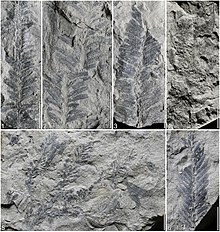
Summary
Palissyales are an extinct order of conifers, known from the Mesozoic. They are best known from the genus Palissya, which is found in Laurasia and Eastern Gondwana dating from the Late Triassic to Early Cretaceous. The only other confirmed genus of the family, Stachyotaxus known from the Late Triassic of the Northern Hemisphere. The genus Knezourocarpon from the Jurassic of Australia has also been tentatively considered a member of the order.[1] The cone of the best known genus Palissya is noted for its unusual construction, which is borne on a large bract (modified leaf), and consists of two parallel rows of ovules that run along the midline of the adaxial surface of the bract which are encased in cup-like structures formed by scales. The bracts are helically arranged around an axis, forming a compound catkin-like structure. The seeds are thin-walled were likely only viable for a short period of time, and were likely adapted to wind dispersal. Palissya has been considered in some aspects to be similar to some Paleozoic Voltziales, as well as Taxaceae and Podocarpaceae.[1]
| Palissyales Temporal range:
| |
|---|---|

| |
| Foliage of Stachyotaxus from the Late Triassic of Germany. | |
| Scientific classification | |
| Kingdom: | Plantae |
| Clade: | Tracheophytes |
| Clade: | Gymnospermae |
| Division: | Pinophyta |
| Class: | Pinopsida |
| Order: | †PalissyalesDoweld 2001
Families and genera
See text
Taxonomy
edit
References edit
|


